b1d4e80b032a087e0da0d58d185c589b.ppt
- Количество слайдов: 190

Prepared By: Texas Commission on Law Enforcement Officer Standards and Education

Your Instructor – Course Facilitator and Mentor Trainer Deputy Chief George D. Little A. S. & B. S. Criminal Justice & Sociology B. S. CJ Wayland Baptist University, San Antonio M. S. Criminology & Counter-Terrorism University of the State of New York(P) 2012 T. C. O. L. E. Professional Achievement Award Certified Crime Prevention Specialist (C. C. P. S. ) TCOLE Basic Instructor Certificate 1984 TCOLE Advanced Instructor 2012 TCOLE Master Peace Officer 1991 MP Special Operations Operator Counter-Terrorism 1988 Military Police Investigations (MPI) & Criminal Investigation Division (CID) Special Agent Graduate Drug Enforcement Administration Academy 1977 3/18/2018 43 - years Law Enforcement Experience 39 -Years Teaching & Instructor Experience 2

Course Registration • Please complete BCCO PCT#4 Course Registration Form. • Make sure you sign TCLEOSE Report of Training Form

Unit Goal: • To increase law enforcement awareness of human trafficking by informational exposure to: – victim identification – Investigation – Rescue and prosecution considerations

Unit Goal - Continued: – Referral and service provider availability – Need for development of coordinated community response, and – Inter connectivity of state, federal, and global concerns.

Objectives

Section 1. 0 Building a Knowledge Base • Describe the concept of Human Trafficking from a global perspective • Discuss definitions of the term human trafficking based on international and U. S. laws • List the different forms of human trafficking • Summarize the history of human trafficking

• Discuss modern trafficking patterns • Discuss factors giving rise to human trafficking • Explain the stages of human trafficking • Describe characteristics predominant in the identification of offenders, victims, and consumers

• Discuss the art of control over victims • Explain the invisibility of victims and the difficulty identifying the victim of human trafficking

Section 2. 0 Investigation Considerations • Explain the observational and investigative cues to help identify trafficked victims • Discuss how to identify trafficking offenders based on specified indicators • Explain the differences in trafficker’s roles

• Discuss case management and interagency cooperation which can aide investigations • Describe victim-centered approach in investigations • Discuss best practices in investigations

Section 3. 0 Legal Issues • Discuss national and international perspectives concerning efforts to end human trafficking • Explain threshold requirements for eligibility of victim benefits and services • Describe victim protection under the law

• List recent changes in human trafficking laws • Discuss the Texas statute on human trafficking

Section 4. 0 Victim Service Providers • Discuss the importance of victim service providers • Summarize the types of victim service providers • List victim service requirements as defined by legal parameter

Section 5. 0 The Collaborative Approach • Explain the importance of inter-agency collaboration • Discuss the importance of seeking help from the community • Discuss human trafficking case studies

• Explain the importance of a proactive response to human trafficking • Discuss challenges and barriers to effective investigations of human trafficking

Section 6. 0 Review and Evaluation

Building a Knowledge Base

1. 1. Describe human trafficking from a global perspective

What is Human Trafficking? • Modern-day slavery • Exploitation for sexual gratification or labor • Controlled by severe punishment – Prevents escapes – Inhibits victims from testifying

Statistics • 21 million people are victims of human trafficking • 800, 000 people are trafficked into the country each year – Some believe this number is an underestimate

• Men, women and children of all ages are victims – Economic and political instability – Economic prosperity and disposable incomes in countries of destination

Numbers escalating • Highly profitable – Third most profitable transnational crime – Profits between $7 -10 billion a year

• Low risk of being apprehended or punished – Drives traffickers to continue – False sense of security – Law enforcements preoccupation with sale of drugs and arms, and terrorism

1. 2. Discuss definitions of the term human trafficking based on International and U. S. laws

International Legislation • The Protocol to Prevent, Suppress and Punish Trafficking in persons defines: – The action of: recruiting, transporting, transferring, harboring, or receiving of persons – By means of: threat or use of force, coercion, abduction, fraud, deception, abuse of power, vulnerability, or giving payments or benefits to a person in control of a victim,

– For the purpose of: exploitation – to include: • forced labor, • slavery or similar practices, and • removal of organs for economic gain Palermo Protocol, 2000

Victims of Trafficking and Violence Protection Act of 2000 • Sex Trafficking – Recruitment, harboring, transportation, provision or obtaining a person for the purpose of a commercial sex act – Act is induced by force, fraud or coercion, or under the age of 18.

VTVA, 2000 • Labor Trafficking: – Recruitment, harboring, transportation, provision, or obtaining of a person for labor services – Act is induced through the use of force, fraud, or coercion – For the purpose of involuntary servitude, peonage, debt bondage or slavery

International vs. Internal Trafficking • International: across borders of countries • Internal (domestic): recruited, sold and enslaved in native countries – Asia (Thailand, China and Africa)

Is the U. S. immune? According to report issued by University of Pennsylvania… – 300, 000 children in U. S. are at risk of international traffickers – Runaway and homeless children highly susceptible to domestic trafficking or commercial sexual exploitation

1. 3. List the different forms of human trafficking

Essentially… • Human Trafficking is slavery or involuntary servitude that thrives on the exploitation of humans for economic gain

• More profitable than other transnational crimes. Humans can be sold over and over to create higher profit margins

Most common forms… • Sex Industry – Prostitute, exotic dancer, exotic entertainer (most commonly women)

• Sex Tourism/Child Tourism – Travel to foreign locations for sexual gratification • Mexico and Latin America – Camel Jockeys, domestic servants, sweatshops

Men as victims • Forced Labor – Agricultural fields for crop harvesting – Construction workers – Restaurant work – Day Laborers – Some forced to work in sex

Is there ever freedom? • Accumulated debt – Purchase of fraudulent travel documents – Travel expenses – Over inflated living expenses – Medical expenses – Trafficker’s commission

Freedom is rarely a reality because the trafficker is constantly adding to the debt

1. 4. Summarize the history of human trafficking

Not a new phenomenon • Dates back to the earliest civilizations…ancient Greece • Fifteenth Century Portuguese Slave Trade • Eighteenth Century Trade: humans for weapons and molasses

Continued… • Nineteenth Century: 13 th amendment passed but plight continued • Twentieth Century: Problem worsened despite concerted international efforts to end such practice

International Convention • First international treaty signed to suppress the trade of human beings BUT, only intended to suppress the trade of white women.

• League of Nations (UN) 1921, initiatives to protect nonwhite women • Next few decades: definite plan still lacking

Today… • More people enslaved today than in human history Old Slavery Legal ownership asserted High purchase cost Low profits Shortage of potential slaves Long-term relationship Slaves maintained Ethnic differences important New Slavery Legal ownership avoided Very low purchase cost Very high profits Surplus of potential slaves Short-term relationship Slaves disposable Ethnic differences not K. Bales (1999) ‘Disposable People

1. 5. Discuss modern trafficking patterns

United Nations Office on Drugs and Crime • Global Trafficking Routes

1. 6. Discuss factors giving rise to human trafficking

• The high profitability of trafficking persons is certainly a factor that contributes to the prevalence of this crime but other factors have also contributed to its pervasiveness.

Examples: • Deregulation of trading opportunities around the globe (free trade) • Economic Marginalization (feminization of poverty) • Advances in communications • Ease of travel

• Political Instability • Rise of regional conflicts • Weapons obtained through transnational crime • Government attention diverted • Decline in border enforcement • NAFTA

Globalization • Some suffer – Extreme poverty • Resulting in: – Criminal activity as option – Women and children become targets – Sale of humans on underground market – Seek employment abroad brings potential for exploitation

Culture/Historical Practices • Ex. Nigeria and Togo – Common: • Parents send children to homes of persons who are able to educate/train • In extreme economic frustration parents agree to sell children for small amounts of money

Supply vs. Demand • So…most victims of human trafficking originate in countries who suffer from instability HOWEVER, as with any business venture, there must be a customer willing to purchase a commodity.

AND… • Countries to profit from free trade or the deregulation of trade have the financial ability to support this transnational crime. • Does it come as a surprise that the United States ranks very high as a destination country for victims of human trafficking?

Seemingly an unstoppable crime • Contemporary Crime Theory: – Traffickers rationalize the gains to be made from the sale and enslavement of humans against the risk of detection and apprehension by law enforcement. If gains outweigh the risk, human trafficking will continue to thrive.

1. 7. Explain the stages of human trafficking

Stages • Stage One: factors that make individuals vulnerable – Dire economic circumstances – Hopelessness – Desire for a better life

• Stage Two: Recruitment Process – Local recruiters that understand culture and victim vulnerability – Media Outlets – Recruitment by Persuasion – Recruitment by Force

• Stage Three: Transportation – Consent through deception – Abducted or forced to travel against their will

• Stage Four: Exploitation – May begin immediately, upon arrival, or when victim identifies deception • Stage Five: Physical Abuse or Torture – For compliance and to prevent escape Methods: assault, beatings, rape, confined living quarters etc.

• Final Stage: Resolution – Some die trying to pay off debt – Killed due to physical torture – Contract sexually transmitted disease If granted freedom: – Shame or ostracism when returning home – Can’t return due to culture norms – Some return and due to same economic situations continue to be vulnerable – Many continue to have health and psychological problems

1. 8. Describe characteristics predominant in the identification of offenders, victims, and consumers

UNDOC offender and victim profile • Offender Characteristics: – Regional patterns (live/operate) – Associated but non-exclusive gender – Ages, educational and occupational backgrounds vary but commonly have a criminal history – Commonly involved in criminal network

• Characteristics of Victims: – Prime regions for recruit are the Commonwealth of Independent States, Asia and Latin America – Ages: differ by region – Low level or no education – Unemployed and limited opportunities – Dire economic circumstances – Social and economic inequality – Regional conflict, military occupation

• Characteristics of Customers: – From all countries but ranked in top include: United States, Canada, Australia, New Zealand – Age, gender, occupation and socio-economic backgrounds all differ Consumers can be anybody willing to pay for the illegitimate services of another and can even be of the same nationality and race as the victims.

1. 9. Discuss the art of control over victims

Why don’t they just leave? • Victims do not choose to remain enslaved. They do NOT however, attempt to escape for fear of harm for themselves or their families. Victims are under control of traffickers at all times.

Control • First achieved through false sense of security • Routine violence or threats of violence (physical assault or rape also used to “break-in” victim) • Restricting movement of victim • Brainwashing

• Psychological manipulation • Isolation • Constant supervision • Dependence on drugs and alcohol In essence, three main elements are used to control victims: force, fraud, and coercion.

• Force: beatings, rape, physical confinement, kidnapping, denial of food/water, denial of medial care/medications, denial of contraceptives/condoms, forced abortion, forced to give up custody of children, forced to use drugs, forced participation in violent or sexual acts, forced to lie.

• Fraud: deceptive employment offers, deceptive marriages, deceptive promises of a better life.

• Coercion: psychological or mental abuse, document confiscation, fines for rule violations, control of children, photographing in illegal situations, forced to watch pornography to learn prostitution or stripping, forced to meet quotas, control of money.

1. 10. Explain the invisibility of victims and the difficulty identifying the victim of human trafficking

Human Trafficking vs. Human Smuggling • “Nested Concepts” • Smuggling: someone is paid to assist in illegally crossing borders. • Trafficking: if the smuggler sells or forces the individual into some type of servitude upon arrival or brought a victim over borders against their will.

Possible Indicators • • Injuries Brands Untreated STD’s Emotional distress or trauma No knowledge of how to move about Guarded/Heavy security Victim provided immediately with attorney or bail

• Person is not in possession of identification documents • Fearful of police • False accusations have been made about neglect to children, etc. • Signs of threats or stalking • Smuggled across borders

Issue of Consent Degrees of victimization Completely Coerced Deceived through promises Full Consent

Illegal Status • Some officers complacent to render help and assistance to victims • In violation of immigration laws • Precludes identification/criminal status • Consented to travel/willing accomplice • If and when an investigation uncovers a human trafficking operation, consent often becomes an overriding factor that will delay a decision to assign a victimstatus to the exploited.

Organized Network • Unclear targets for investigation • Lack of tools by law enforcement to conduct effective investigations • Lack of trained law enforcement

Fear of Self-Disclosure • • • Punished by traffickers if found out Fearful of Police Illegal status Use of forged documents Constant supervision makes it difficult to contact authorities • Language barrier • Unaware of legal rights

Investigation Considerations

2. 1. Explain the observational and investigative cues to help identify trafficked victims

Observational Cues • Visible injuries on a person • Burns, cuts, brands, scars on wrists, ankles and legs • Malnourishment • Poor personal hygiene • Dirty clothing • Dirty living conditions

Other than visual indicators: • Signs of emotional distress or trauma • Gaze aversion • Cowering • Presence of chaperons/guards • Non-English speaking

Asking Questions… • Ask questions in a – Non-threatening manner – Non-authoritative manner – Safe environment – Supportive manner and – Build trust slowly

Be attuned to… Correlation between verbal and nonverbal communications • Non-verbal: 70% of message communicated this way. Examples: dryness of mouth, excessive sweating, posture, grooming gestures, personal gestures and facial expressions.

• Verbal: Examples: vocabulary, speech patterns, and accent/dialect • Paralinguistic: Examples: tone or pitch of voice, response latency, and length of response.

Be attentive to responses… • How did they enter the United States? • Who was in control of documents during their travel to the U. S. ? • How did they pay for their travel? • Who made travel arrangements? • Who accompanied them during their travel?

• Were they aware of their travel plans and place of destination? • Did they or someone else acquire fraudulent travel documents? • What were they told to say to immigration officials when they arrived?

Scenario/Role-play

Responses about employment • Did they come to the U. S. for a specific job or purpose? • What type of employment do they have? • Who is their employer? • How much money are they paid a week/month? • Do they owe any money and/or services to their employer? • Is there an employment contract? What are the terms?

• Were they forced to have sex as part of employment? • Can they freely leave their place of employment? • What happens if they make a mistake at work? • Does the employer hold wages? • Are there guards or video cameras to monitor their activities? • Are they pleased with their employer/employment?

Scenario/Role-play

Concerning Safety and Coercion… • Has victim or their family been threatened with harm if they try to leave? • What is their understanding of what would happen if they tried to leave? • Have they been physically harmed, deprived of food, water, sleep, medical care, or other life necessities?

Scenario/Role-play

Also crucial information… • Are they allowed to buy clothing and food on their own? • Can they come and go as they please? • Can they freely contact (phone, write) friends and family? • Are they free to have a relationship with someone? • Are they isolated from the community? • Can they bring friends home?

Scenario/Role-play

El Monte Case • Example of Forced Labor • Public Outcry of this case led to the passage of the Trafficking Victims Protection Act of 2000

2. 2. Discuss how to identify trafficking offenders based on specified indicators

Identifying Offenders • Inferential tools (indicators): based “on the probability that the particular event is similar enough to prior events to warrant a current deduction” (Webb/Myers, 2001).

Indicators • Migration: First cue to be analyzed. – Transported illegally – Travel in small groups accompanied by chaperone/guard – Will meet other transporters at port of entry/transit/exit – Forged documentation will be in possessions – Financial means may be funded by an organized group

• Recruitment: by-persuasion and byforce (which usually means organized crime group involvement) – Degree of coercion – Degree of force – Degree of fraud and deception, could also link to crime groups

• Magnitude (of the operation): Labels type of group involved: – Larger operation-organized effort – Distance traveled-local or international – Substantial funds-minimal funds Smaller organized networks of criminals usually perform “grunt” work and are linked to a larger, more sophisticated criminal organization.

• Victim’s Mens Rea (Criminal Intent): – Victims sometimes collude with traffickers – The more elaborate the scheme the more chance victim had little or no awareness of criminal activity and their fate

Continuum Victim vs. Offender Full Awareness Of Outcome Some Awareness of Outcome No Awareness of Outcome

• Retribution (for non-compliance) – Retributive threats or assaults on family of victim (indicator of organized crime) – Profit Margin – Ability to bribe officials

• Intelligence (requires law enforcement collaboration on all levels) – Most notable organized crime groups involved in trafficking: Russian Mafia, Chinese Triads, Japanese Yakuza. – Others from newly independent states and Asia: Ukrainian or Red Mafia, Albanian, Italian and Turkish Mafias, Taiwanese, Thai and Vietnamese Crime Groups – From other parts of the world: India, Nigeria, West and South Africa.

Differences in Old vs. New Crime Groups – Crime groups established prior to 1990’s have traditional hierarchical structures with an identifiable mafia boss; new groups are more lateral and fluid. – Older mafia’s do not specialize in one crime. May be involved in money laundering, arms trafficking and human trafficking Exception: Chinese Triads: does not have a structure.

2. 3. Explain the differences in trafficker’s roles

Recruiter • Finds and brings victims into industry (sometimes by force) • Sell victims to brokers, employers, brothel owners or bar owners

Broker • Go-between or middleman • Buy victims from recruiter and sell to an employer • There could be more than one broker

Contractor • Organizer • Oversees entire trafficking transaction • Role of a relatively professional criminal or organization

Employment/Travel Agent • Arranges for the trip and alleged purpose • Arranges for a “legitimate” job and job description • Arranges for a “legitimate” trip • May serve as fronts for trafficking activity • Also, may arrange for victims “legitimate” documents

Document Thief/Forger • Arranges and obtains “legitimate” documentation for travel to another country • May create false or steal documentation • Position is usually an immigration officer or lawyer

Transporter • May be called a “jockey, ” “escort, ” “coyote” • Accompanies victims on trip to their destination via one or more transit cities or countries • Delivery to broker or employer

Employer (procurer) • Purchases than sells victim to customer • Provides a place of employment • Provides victim with a place to live • Informs victim of demands A small number of employers may be street pimps and have no business establishment

Enforcer • • • May be called a “guard, ” or “roof” Provides protection for place of business Minimal protection provided to victim Enforce demands placed on victims Verify victims do not escape Make sure customer pays for services

Note… • Tasks and functions may be carried out in different parts of the globe • Some tasks may be carried out by mom and pop organizations • Not unusual for recruiters to be from same town as victim and a known individual

2. 4. Discuss case management and interagency cooperation which can aide investigations

Collaboration is Key • Agencies to be involved: – Local department Protocol – Local office of Federal Bureau of Investigation (FBI) – Local Immigration and Customs Enforcement (ICE) – Local Federal Prosecutor – Department of Justice (DOJ) – Local Non-governmental Organizations (NGO’s) – Local Victim Service Providers

Texas • Has its own anti-trafficking law so contact with federal and state prosecutors is pertinent. • Regardless of prosecution level, all agencies needed for successful investigation

Assistance Roles • FBI: – – – – Provide resources lacking at local level assist with surveillance computer evident recovery document analysis translation services cases leading to overseas arrest victim safety request “continued presence” (legal means to stay in the U. S. )

• ICE: – Investigative and enforcement responsibilities – Human Smuggling and Trafficking Unit identifies individuals/organizations – Assist with surveillance, continued presence requests or T-visas, overseas investigations, immigration status review, border interdiction, translation, victim and witness assistance

• DOJ: – Criminal Rights Division’s Criminal Section – Proactive in prosecution – Multi-agency task force – Training for first responders – Hotline

• U. S. Attorney’s Office – Responsible for coordinating federal-level trafficking investigations and prosecuting trafficking cases – Provide assistance with victim interviews, victim assistance, witness assistance, convening grand juries, trial preparation – They may also elect to prosecute at local level

Depending on type of Human Trafficking… • U. S. Department of Labor’s Wage and Hour Division (WHD) – Enforcement of labor laws: minimum wage, overtime pay, child labor, enforcement of Migrant and Seasonal Agricultural Workers Protection Act (MSPA)

Memorandum of Understanding (MOU) • Ensure a clear understanding of roles, responsibilities, processes, and protocols for identifying and serving victims of human trafficking, and • Build and/or enhance collaborative efforts between law enforcement and trafficking victim service providers that help leverage limited resources which strengthen, not duplicate, existing victim service efforts.

2. 5. Describe victim-centered approach in investigations

• Victim Service Providers – Assist in building rapport with victim – Safe and more non-threatening environment – Need understanding of human needs for successful interview techniques (Maslow's Hierarchy of Needs)

Maslow’s Hierarchy of Needs


Interviewing Children • • Find interviewer trained for children Conduct interview at child’s level Rapport building is different Empowering child is vital Reassure of safety Assure they are not to blame Assure you are there to help Because children have a tendency not to relate a story in chronological order, multiple interviews may have to be conducted but in short sessions.

In Addition… • Interview victim and trafficker separately • Find a trustworthy interpreter • Give victim choice of male or female interviewer • Unless policy…do not audio or videotape initial conversations • Informal conversation vs. Direct Questioning • Keep note taking to a minimum

• • Allow enough time Do not make promises Be aware of Stockholm Syndrome Cultural/Religious background awareness

2. 6. Discuss best practices in investigations

Elements • Be proactive • Collaboration with other law enforcement agencies • Collaboration with social service providers • Safeguarding the rights of victims and ensuring their safety • Awareness of legal issues • Engaging the community

Blackjack Case • • • Scenario The Case Investigation/Prosecution Collaboration Result

Legal Issues

3. 1. Discuss national and international perspectives concerning efforts to end human trafficking

Review of efforts • 1949: International treaty to suppress the sale of humans (UN) • 2000: Palermo Protocol Are the signatory countries adhering to their agreement?

United States • 2000: The Victims of Trafficking and Violence protection Act (VTVPA) – 3 level approach • Prevention • Punish • Protection

Level One: Prevention • Identification of traffickers • Creation of law enforcement task forces • Education • Monetary Assistance – For employment opportunities – Prevention efforts (Tier System)

Tier System • Tier 1: Countries that fully comply with the acts minimum standards for the elimination of trafficking. • Tier 2: Countries that do not fully comply with the minimum standards but are making significant efforts to bring themselves into compliance

• Tier 2 watch List: Countries on Tier 2 requiring special scrutiny because of a high or significantly increasing number of victims; failure to provide evidence of increasing efforts to combat trafficking in persons; or an assessment as Tier 2 based on commitments to take action over the next year.

• Tier 3: Countries that neither satisfy the minimum standards nor demonstrate a significant effort to come into compliance. Countries in this tier are subject to potential nonhumantarian and non-trade sanctions.


Level Two: Punish • It’s a crime • Up to 20 years in prison if convicted • Life in Prison if victim is a child, victim dies, is kidnapped or endures severe sexual abuse • Up to 30 years in prison for U. S. citizen to travel to another country for purposes of sex tourism
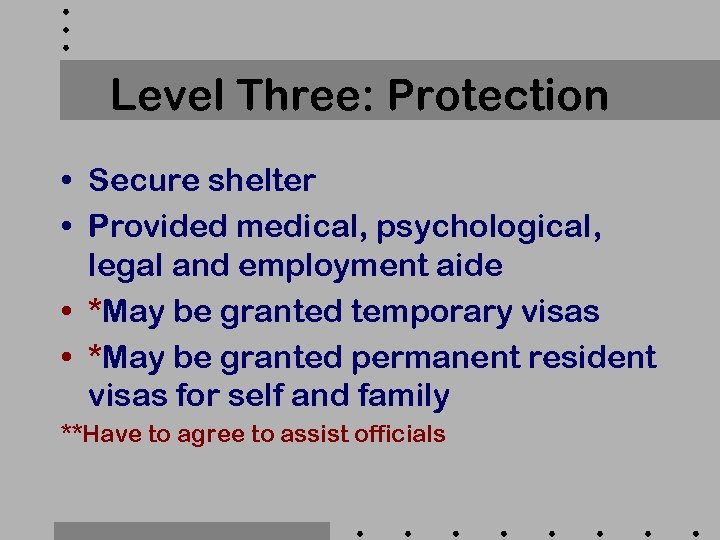
Level Three: Protection • Secure shelter • Provided medical, psychological, legal and employment aide • *May be granted temporary visas • *May be granted permanent resident visas for self and family **Have to agree to assist officials

3. 2. Explain threshold requirements for eligibility of victim benefits and services
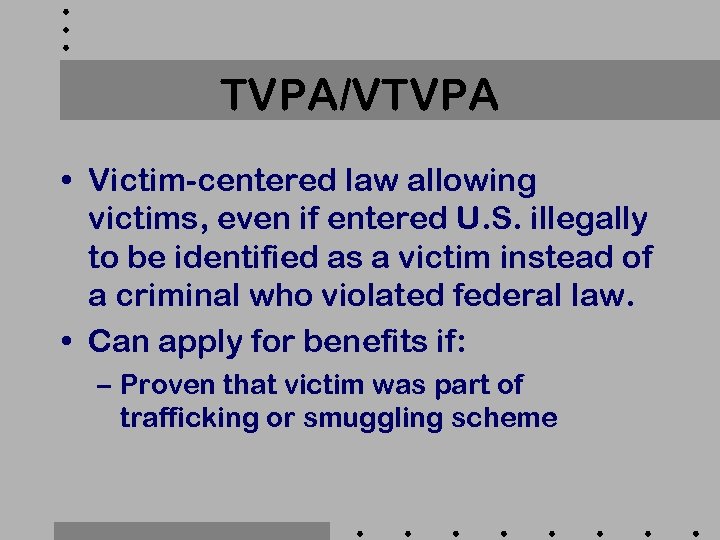
TVPA/VTVPA • Victim-centered law allowing victims, even if entered U. S. illegally to be identified as a victim instead of a criminal who violated federal law. • Can apply for benefits if: – Proven that victim was part of trafficking or smuggling scheme

– Force, threats, psychological manipulation, or confiscation of legal documents were utilized – If so, victim legally defined as a “severe victim of human trafficking. ”
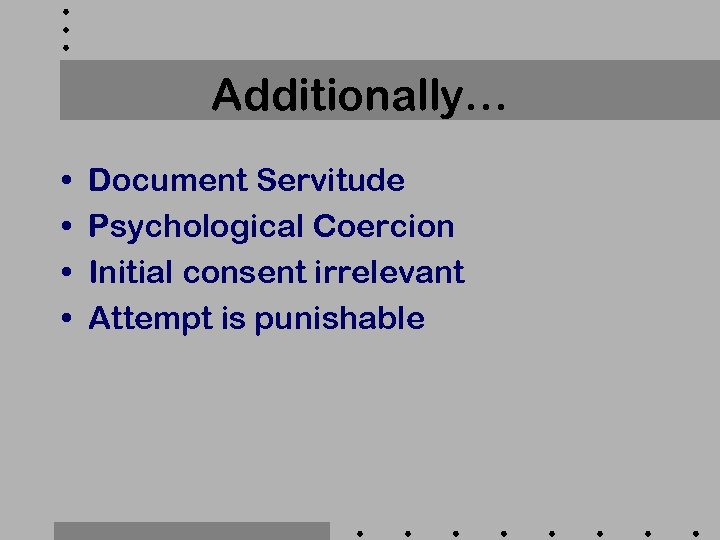
Additionally… • • Document Servitude Psychological Coercion Initial consent irrelevant Attempt is punishable

As of September 2006 • 24 states passed criminal statues • 8 states passed legislation to create task forces • 3 states pending anti-trafficking criminal bills • 1 state pending legislation for task force • 3 states passed additional legislation • 9 states have Sexual Servitude of a Minor Clause
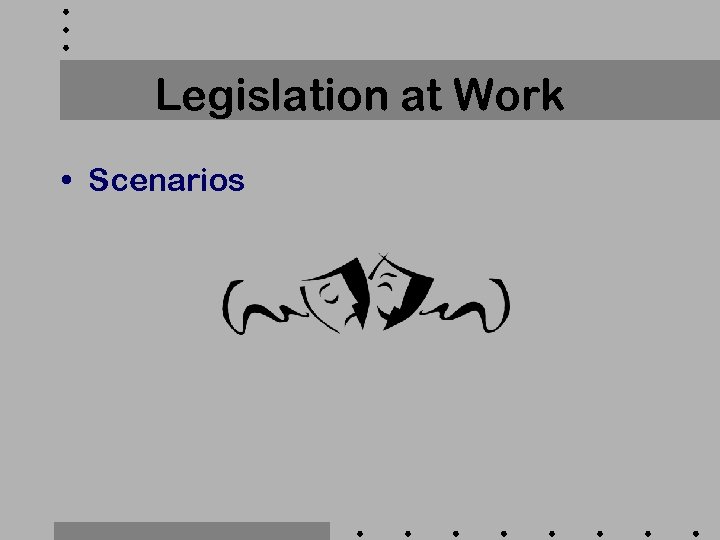
Legislation at Work • Scenarios

3. 3. Describe victim protection under the law
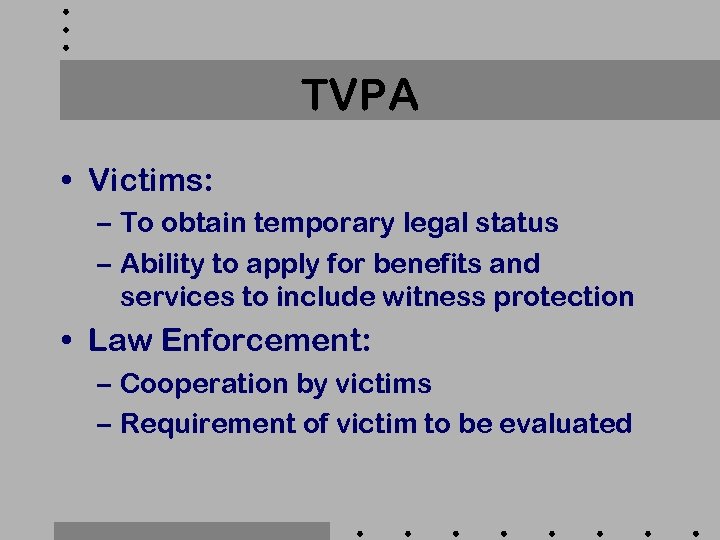
TVPA • Victims: – To obtain temporary legal status – Ability to apply for benefits and services to include witness protection • Law Enforcement: – Cooperation by victims – Requirement of victim to be evaluated
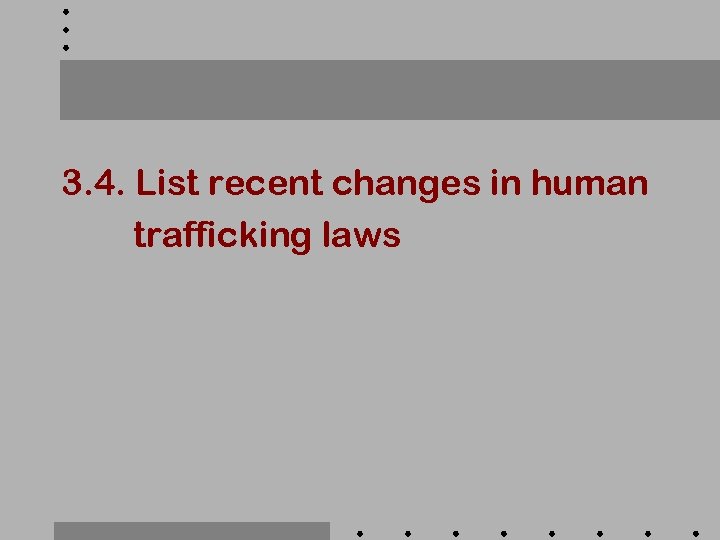
3. 4. List recent changes in human trafficking laws
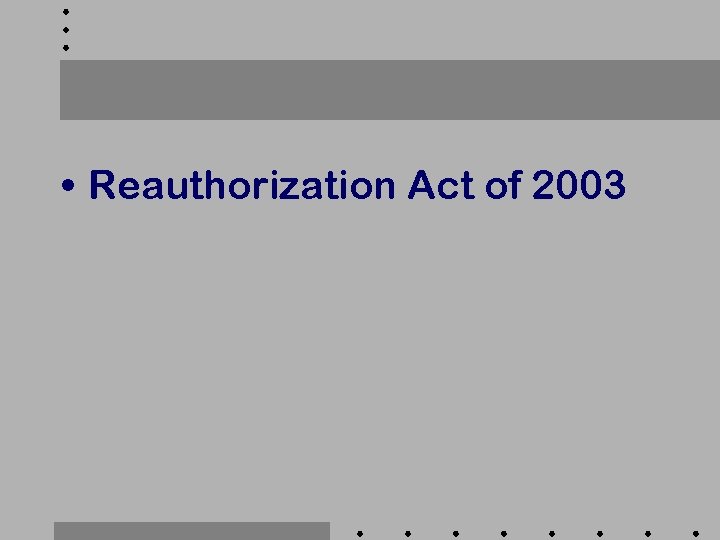
• Reauthorization Act of 2003
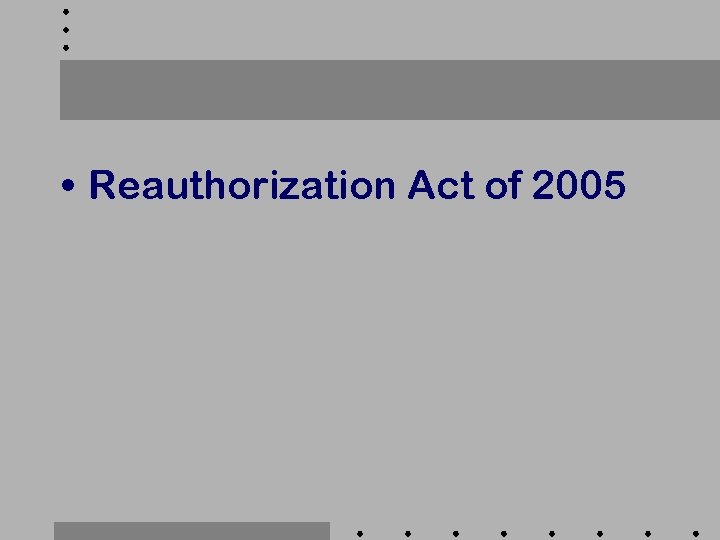
• Reauthorization Act of 2005
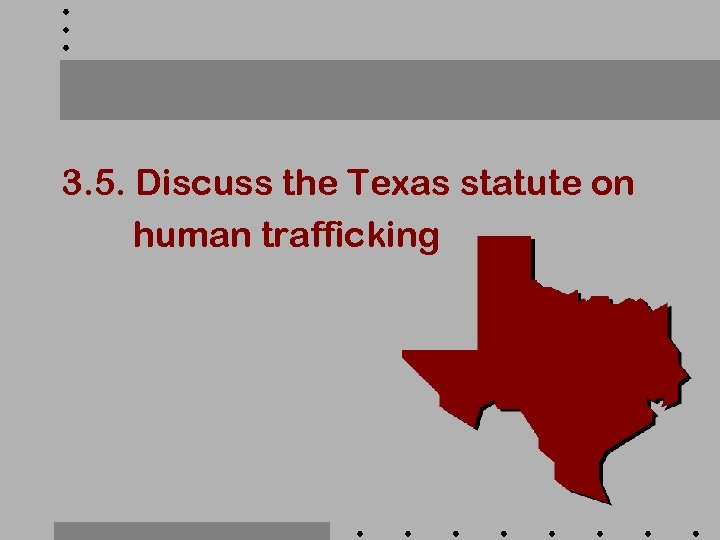
3. 5. Discuss the Texas statute on human trafficking
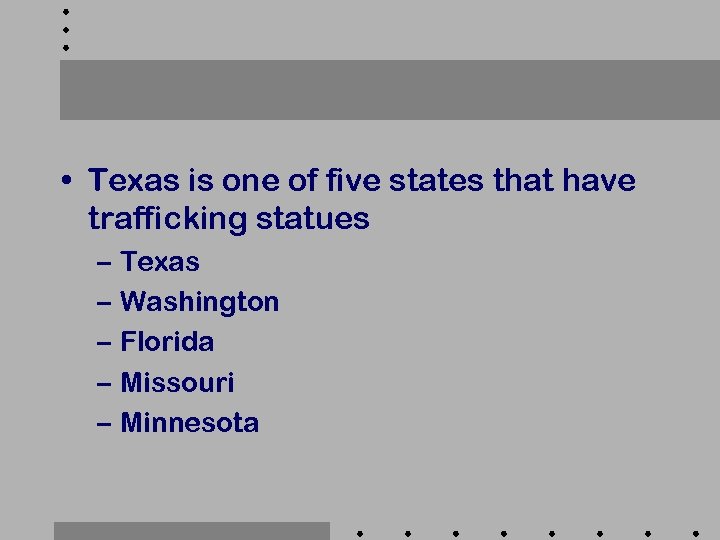
• Texas is one of five states that have trafficking statues – Texas – Washington – Florida – Missouri – Minnesota
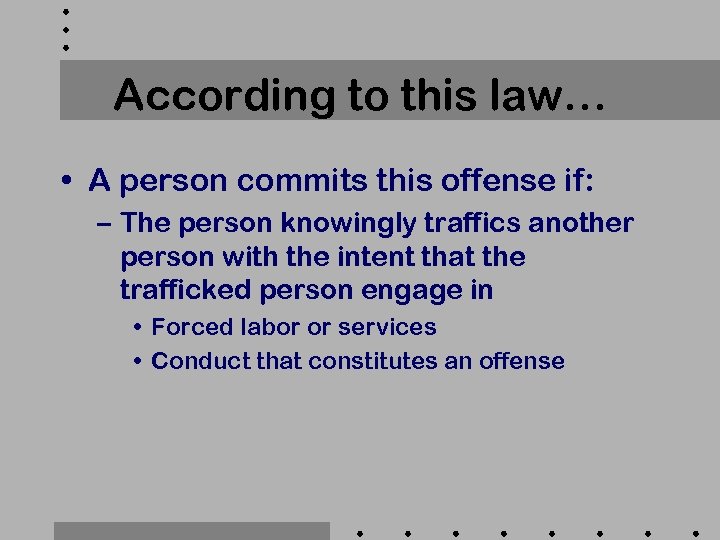
According to this law… • A person commits this offense if: – The person knowingly traffics another person with the intent that the trafficked person engage in • Forced labor or services • Conduct that constitutes an offense
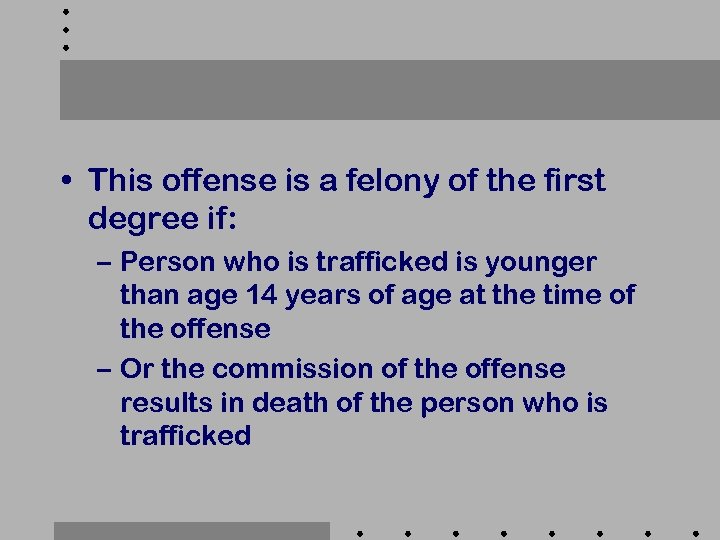
• This offense is a felony of the first degree if: – Person who is trafficked is younger than age 14 years of age at the time of the offense – Or the commission of the offense results in death of the person who is trafficked
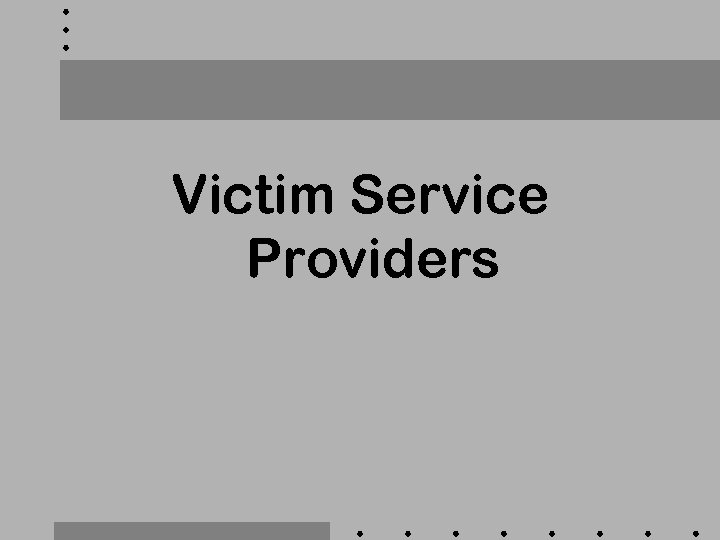
Victim Service Providers
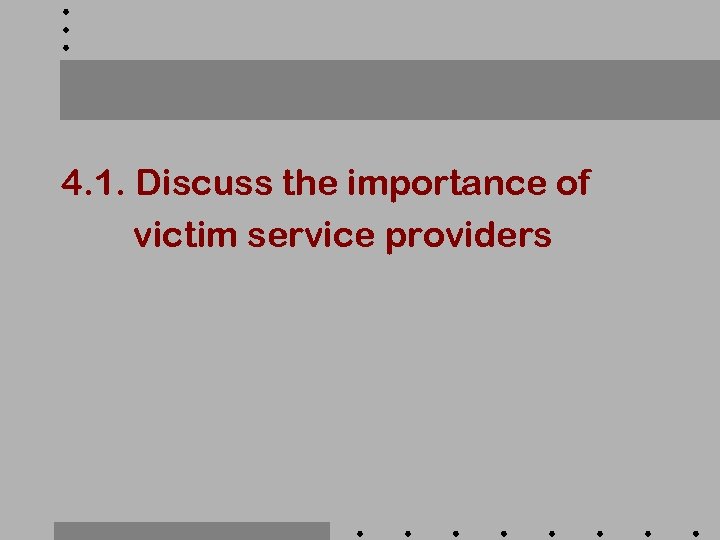
4. 1. Discuss the importance of victim service providers
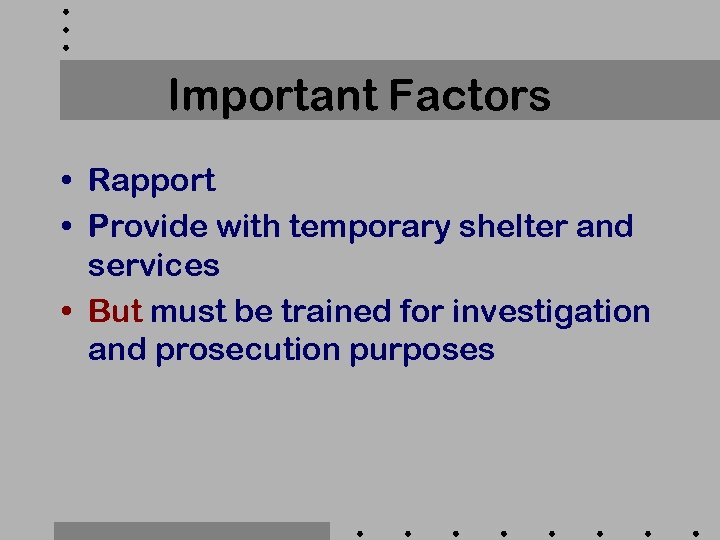
Important Factors • Rapport • Provide with temporary shelter and services • But must be trained for investigation and prosecution purposes
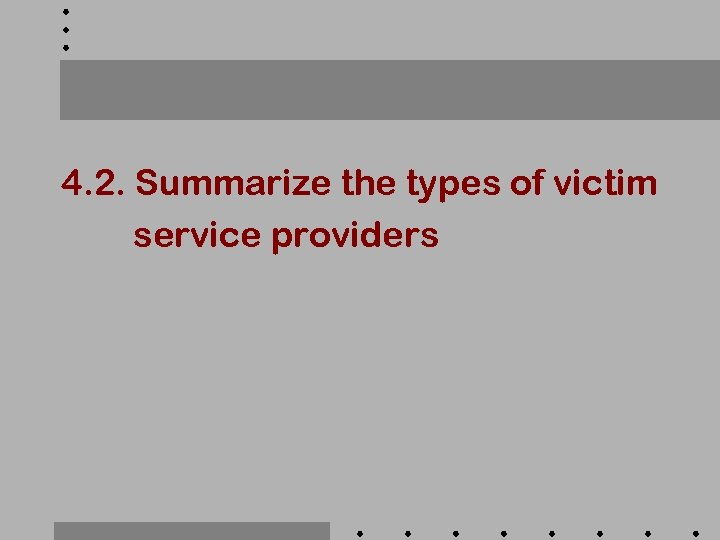
4. 2. Summarize the types of victim service providers
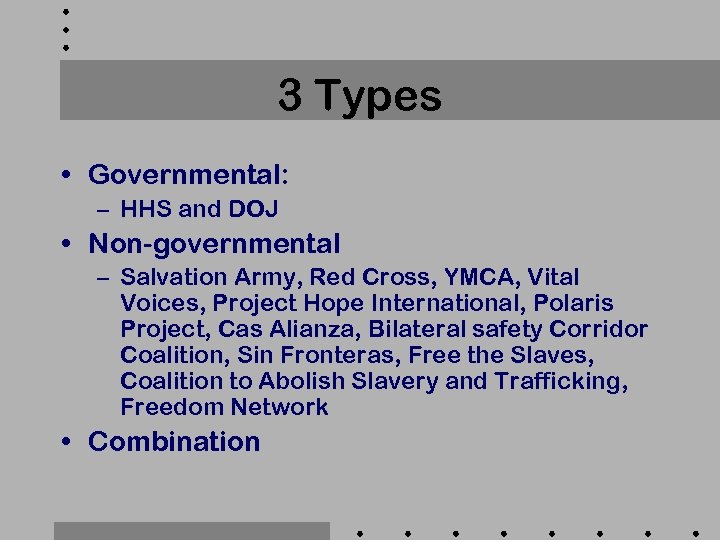
3 Types • Governmental: – HHS and DOJ • Non-governmental – Salvation Army, Red Cross, YMCA, Vital Voices, Project Hope International, Polaris Project, Cas Alianza, Bilateral safety Corridor Coalition, Sin Fronteras, Free the Slaves, Coalition to Abolish Slavery and Trafficking, Freedom Network • Combination
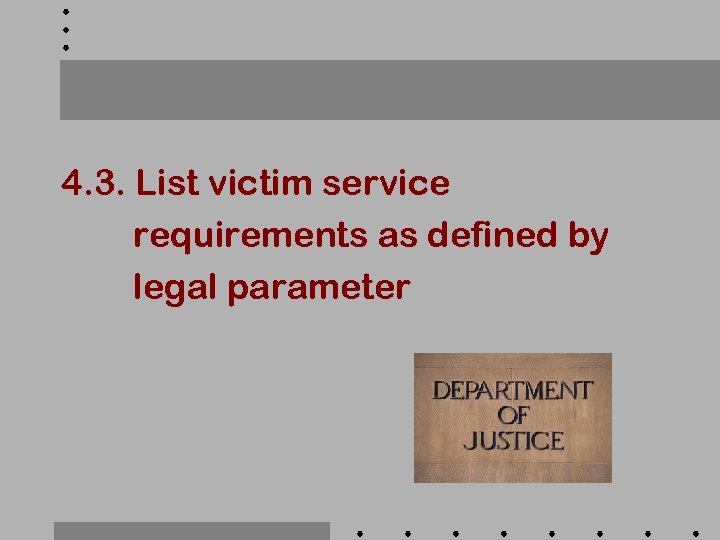
4. 3. List victim service requirements as defined by legal parameter
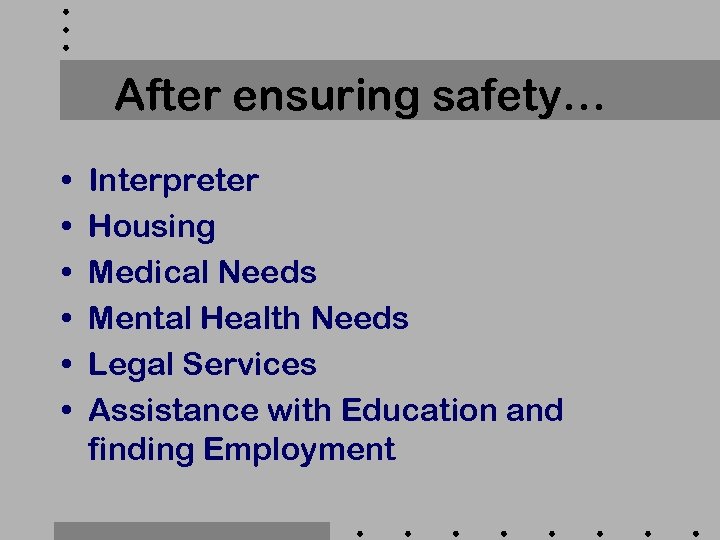
After ensuring safety… • • • Interpreter Housing Medical Needs Mental Health Needs Legal Services Assistance with Education and finding Employment
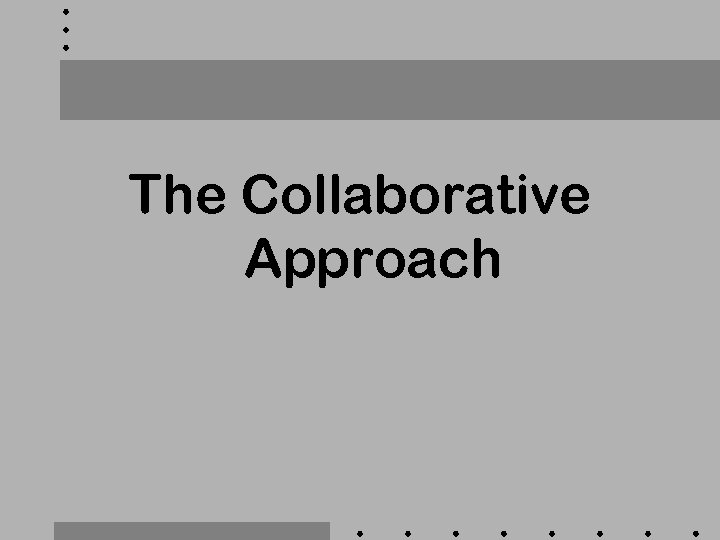
The Collaborative Approach
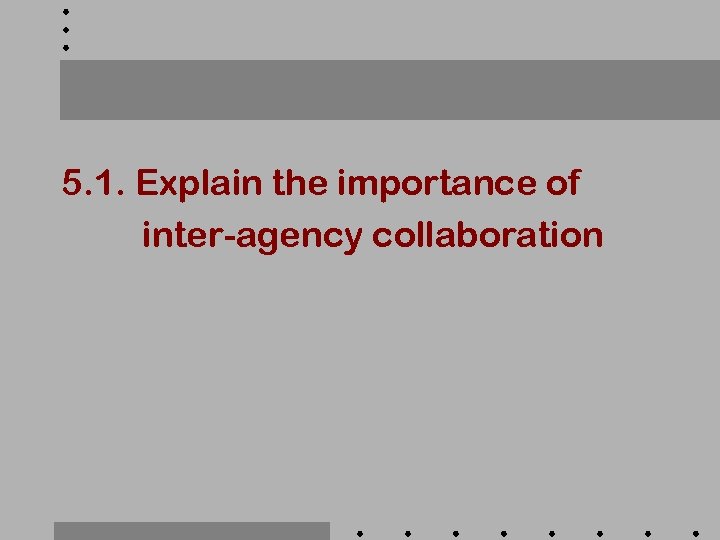
5. 1. Explain the importance of inter-agency collaboration
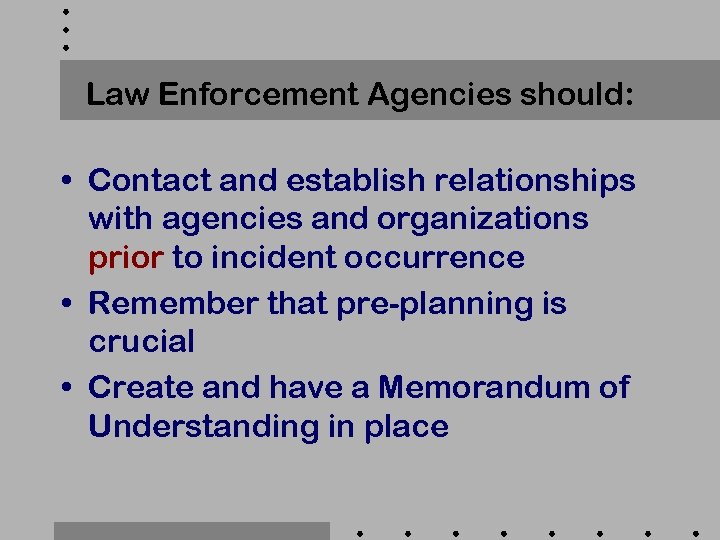
Law Enforcement Agencies should: • Contact and establish relationships with agencies and organizations prior to incident occurrence • Remember that pre-planning is crucial • Create and have a Memorandum of Understanding in place
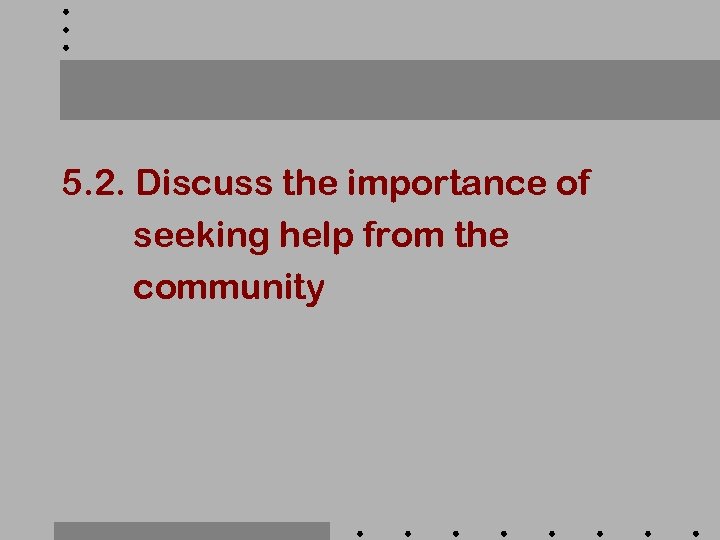
5. 2. Discuss the importance of seeking help from the community
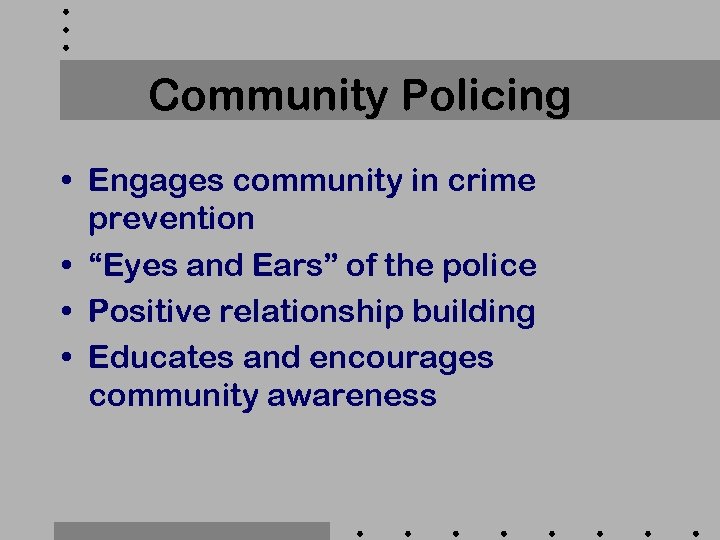
Community Policing • Engages community in crime prevention • “Eyes and Ears” of the police • Positive relationship building • Educates and encourages community awareness
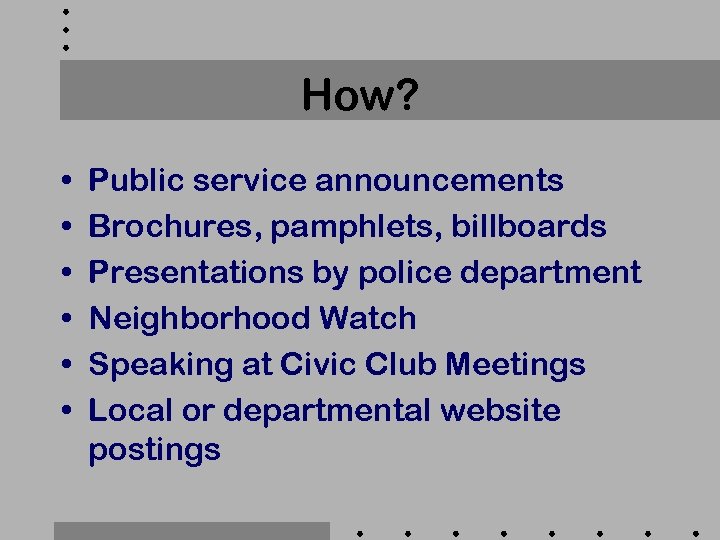
How? • • • Public service announcements Brochures, pamphlets, billboards Presentations by police department Neighborhood Watch Speaking at Civic Club Meetings Local or departmental website postings
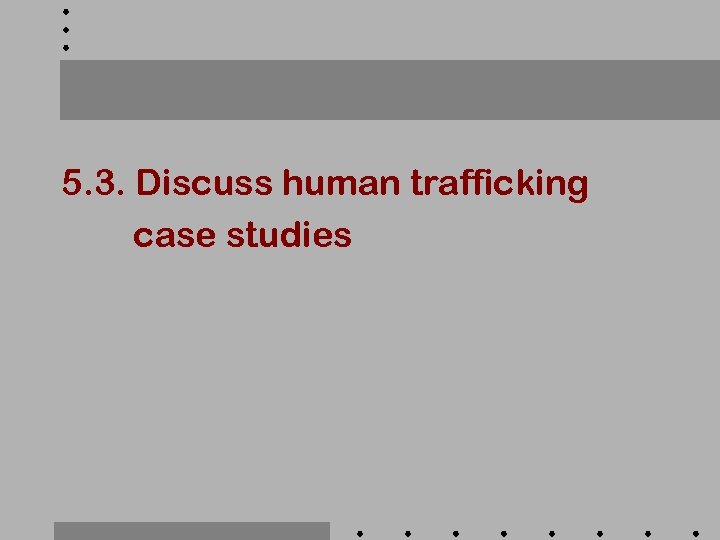
5. 3. Discuss human trafficking case studies
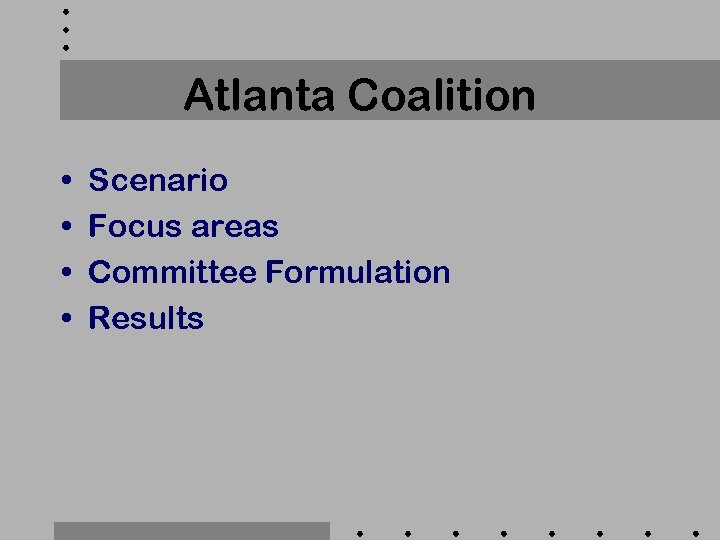
Atlanta Coalition • • Scenario Focus areas Committee Formulation Results
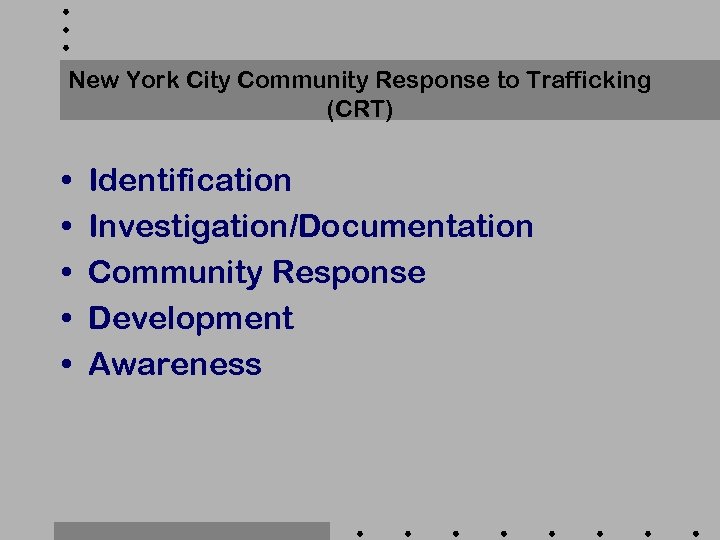
New York City Community Response to Trafficking (CRT) • • • Identification Investigation/Documentation Community Response Development Awareness
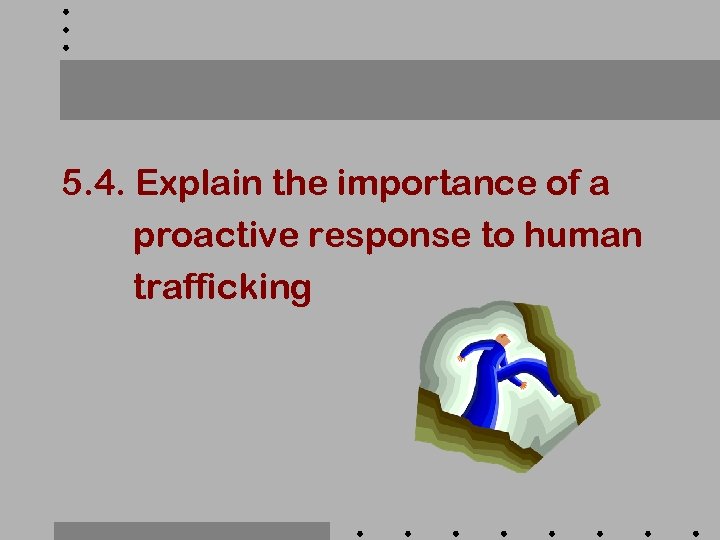
5. 4. Explain the importance of a proactive response to human trafficking
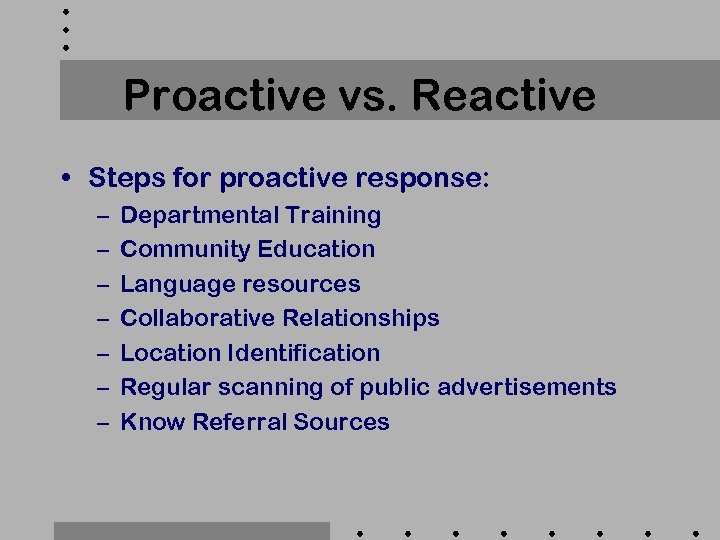
Proactive vs. Reactive • Steps for proactive response: – – – – Departmental Training Community Education Language resources Collaborative Relationships Location Identification Regular scanning of public advertisements Know Referral Sources
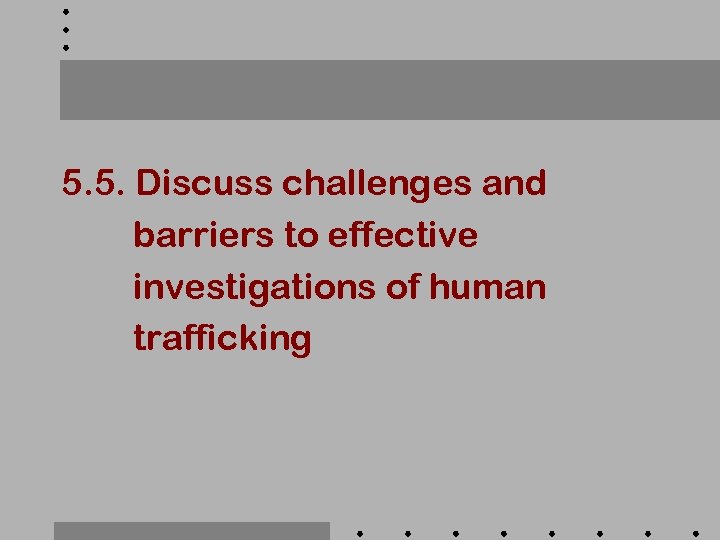
5. 5. Discuss challenges and barriers to effective investigations of human trafficking
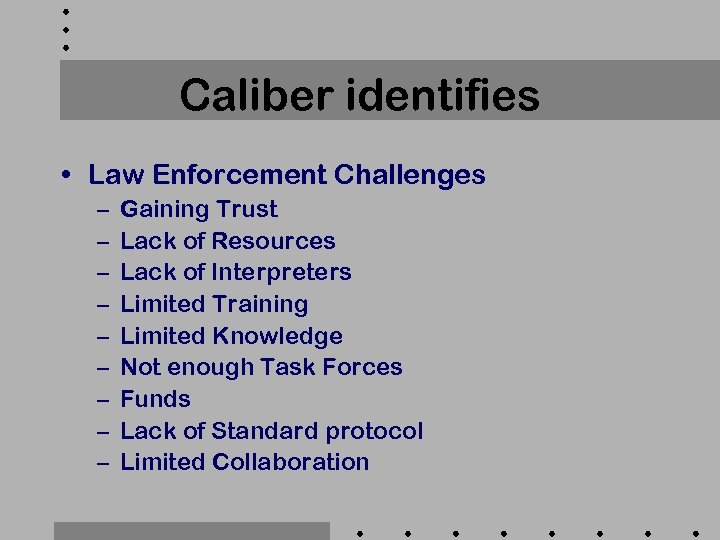
Caliber identifies • Law Enforcement Challenges – – – – – Gaining Trust Lack of Resources Lack of Interpreters Limited Training Limited Knowledge Not enough Task Forces Funds Lack of Standard protocol Limited Collaboration

• Concluding Thoughts
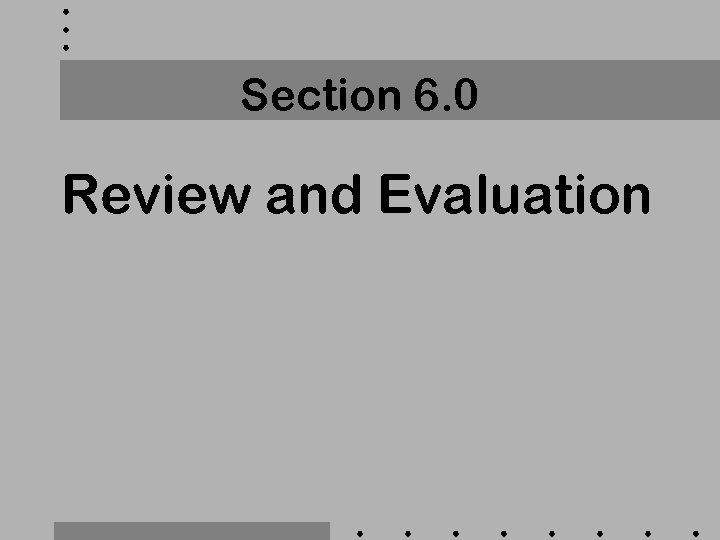
Section 6. 0 Review and Evaluation
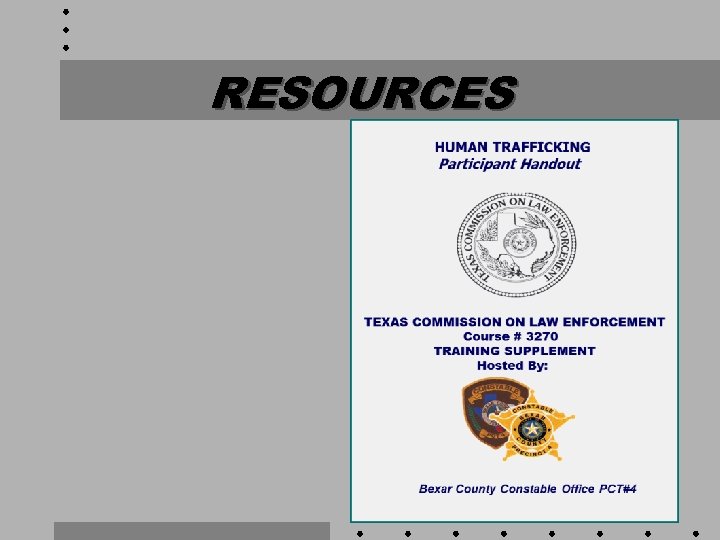
RESOURCES
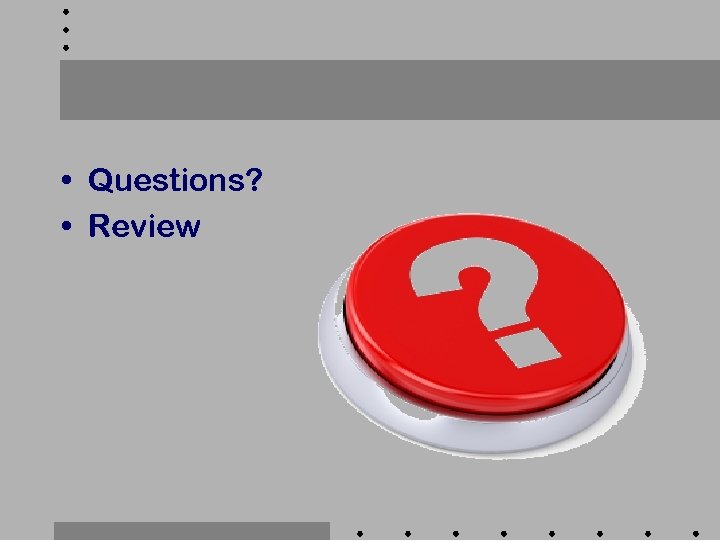
• Questions? • Review
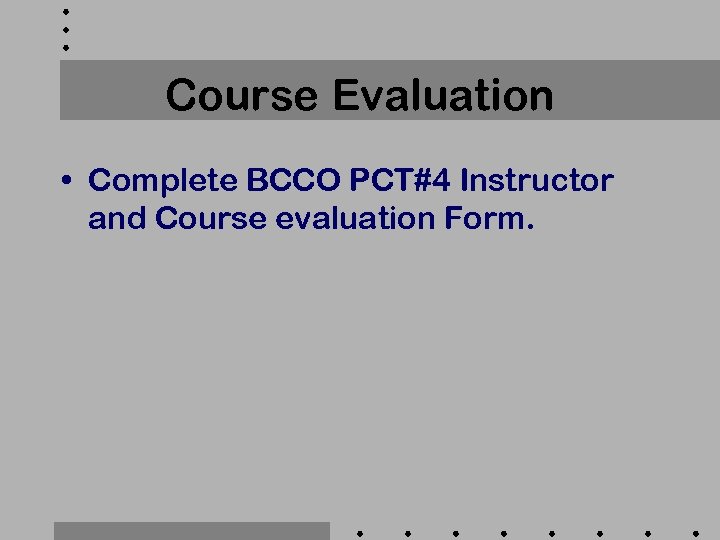
Course Evaluation • Complete BCCO PCT#4 Instructor and Course evaluation Form.
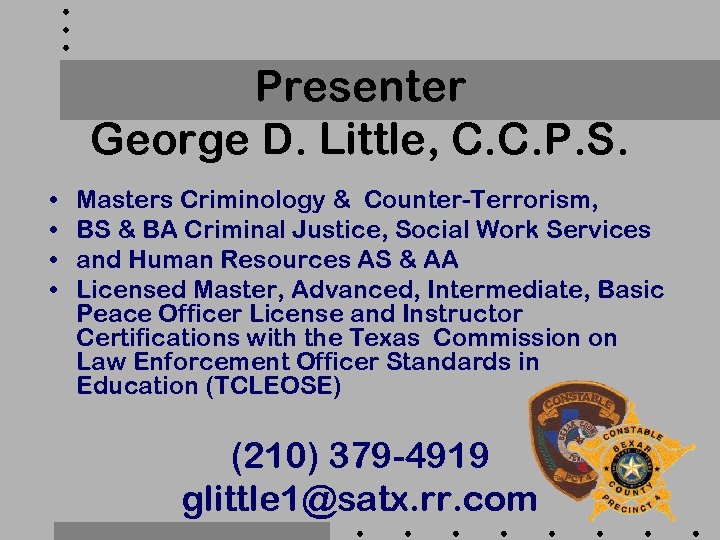
Presenter George D. Little, C. C. P. S. • • Masters Criminology & Counter-Terrorism, BS & BA Criminal Justice, Social Work Services and Human Resources AS & AA Licensed Master, Advanced, Intermediate, Basic Peace Officer License and Instructor Certifications with the Texas Commission on Law Enforcement Officer Standards in Education (TCLEOSE) (210) 379 -4919 glittle 1@satx. rr. com
b1d4e80b032a087e0da0d58d185c589b.ppt